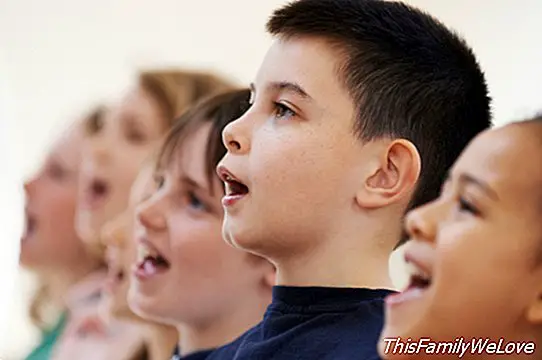Childish dysphonia: how to educate children's voices
Children's dysphonia they are voice disorders that affect children between the ages of 6 and 10 years. Generally, these disorders are not severe and do not usually involve the complete loss of voice in a prolonged or permanent manner. Through a series of vocal habits at an early age, you can educate the voice.
We could define dysphonia as a voice alteration that affects one or several of its basic acoustic characteristics: its height, timbre or vocal quality or its intensity. These are "hoarse" voices with more or less loss of air when speaking, voices that "do not sound good" muffled, deaf, dark, without brightness or color, sometimes with an excessive nasal component.
How to detect a child's dysphonia
Frequently, childhood dysphonia is not detected in the family. Sometimes, discrete alterations of the voice do not alarm the parents, especially in family environments where the mother or father speaks with great intensity, or if someone presents a dysphonic voice.

In these environments it is easy for the child to end up imitating the vocal behavior; Therefore, the vocal model offered by parents is important since the child usually identifies with the communicative style, whether it is calm, nervous, dialoguing, aggressive, etc.
On many occasions, it is at school that problems are detected in relation to speech or speech. Therefore, it is important that the school environment is sensitized and prepared to be able to detect initially a child voice disorder and in this way, guide the parents and be able to perform a preventive task or direct towards a specific treatment.
Vocal habits of children
On the other hand, also at early ages can be carried out an education of the voice through a series of vocal habits that have to do with attitudes as simple as knowing how to listen and speak respecting others, respecting the shifts in the interventions , do not shout or shout, do not force the voice when singing, do not abuse the voice in environments with background noise, etc ...
One factor that can negatively influence vocal education is the example of the protagonism of the abusive use of television: the form of oral expression is in line with the contents, values and presentation transmitted by many programs and the voices can acquire aggressive characteristics and metal bells.
The larynx of the baby
In the global development of the child, the voice goes through different periods in relation to its maturation and development. At the time of birth, the baby's larynx has dimensions equivalent to one third of the size that an adult reaches. The baby can emit high-pitched sounds with a frequency of around 500 cycles per second, which initially respond to reflex manifestations in the face of pleasure, pain or disgust and which manifest as laughter or crying. Little by little, the sounds emitted will be differentiated to pass from the babbling to the syllabic game, until the emission of the first words approximately towards the year of life.
The vocal cords of the newborn lack vocal ligament, a structure that supposes an intermediate stratum between the surface of the cord or mucosa and the vocal muscle, which has great functional importance as far as phonation is concerned. Its absence implies a greater susceptibility to microtrauma and the formation of vocal nodules.
Changes in the voice of boys and girls
In children, at age 13, the larynx begins a growth that will culminate with the acquisition of the voice record of an adult man; the voice becomes more severe, its frequency decreases by an octave while the larynx increases in all its dimensions.
The vocal cords of the child not only differ from those of the adult in size (6-8 millimeters in the newborn versus 8-16 millimeters in the adult) but also in the histological structure and anatomical characteristics of the same.
In the case of girls, this process is much more subtle, since the frequency of the voice descends three or four semitones in the tonal height, acquiring over the years, the expressive maturity of an adult woman.
Respiratory capacity of children
Also, at the respiratory level, the child develops an increase in the vital respiratory capacity, developing the lungs and the thoracic cage. This respiratory functional development will allow you to use more volume of air at the time of expressing yourself and will be able to enunciate phrases of increasing duration with greater comfort. Also, the breathing of the child or adult, vary according to the activity they perform.
In addition to these functional aspects that allow breathing to be used in a way that suits a certain circumstance, we must take into account other aspects of a psychological nature that influence breathing.The diaphragm, the essential muscle of breathing, is the most emotional of all the muscles of the body. We have all found that emotions impact on breathing: when we are excited, breathing accelerates, when we are sad the movements are "limited". Thus, the respiratory flow is modified before any sensory stimulus.
Therefore, we say that from childhood, the diaphragm responds immediately to the impact of emotional life. If this muscle usually maintains excessive tension, over time this tension can become chronic and prevent this muscle from elastically performing its function, affecting other muscle groups involved in inspiration and expiration.
We can appreciate these situations in children and adolescents who have a muscle block located in areas of the thorax or abdomen; The consequence is a lack of support in the voice, an aspect that can influence the appearance of vocal disorders.
Maria Teresa Molina,Speech therapist and Secundino Fernández,Otolaryngologist from the Otorhinolaryngology Department of the University Clinic of Navarra.




